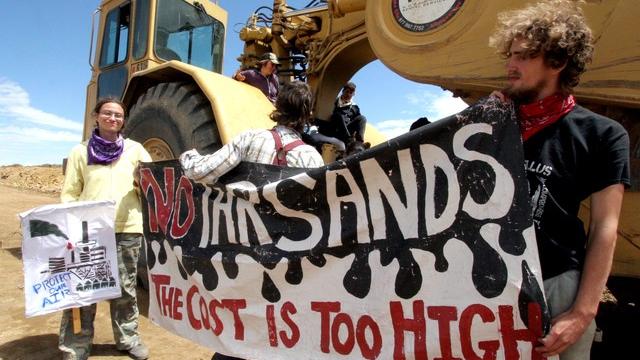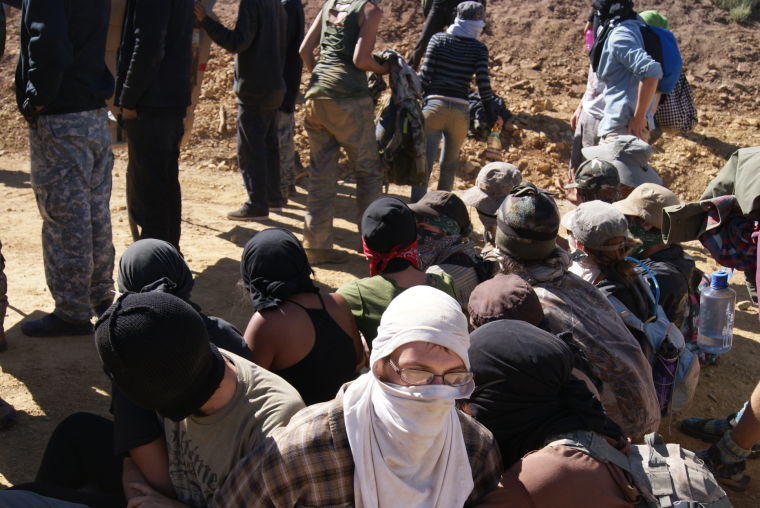
Twenty-one activists were arrested Monday during a "blockade" of a tar sands company’s construction equipment in eastern Utah, according to anti-tar sands groups who accused Uintah County sheriff’s deputies of "brutality."
The Sheriff’s Office declined to confirm the arrests Monday afternoon, except to say that all of its available deputies were at the site about 50 miles south of Vernal. By Monday night, the Sheriff’s Office still had not commented on the arrests.
Beginning at 6 a.m., 80 protesters associated with Utah Tar Sands Resistance physically blocked access to the equipment being stored off Pope Well Ridge Road, near where U.S. Oil Sands is beginning work on Utah’s first commercial fuel-producing tar sands mine at PR Springs.
Several protesters entered a fenced enclosure and locked themselves to equipment, according to protester spokeswoman Jessica Lee. Deputies arrested 13 Monday morning, loading them into white county vans, according to activists’ posts on Twitter and Facebook.
Those who were not immediately arrested remained on nearby Seep Ridge Road to "[make] sure that our comrades are not going to be abused by the police and make sure that they are being treated fairly," Lee told a reporter.
Another six were arrested while blocking the road and demanding their friends’ release, according to the Facebook post by Peaceful Uprising, and late Monday afternoon, Utah Tar Sands Resistance tweeted that two more were arrested outside the Uintah County Jail, bringing the total number of arrests to 21.
"Uintah sheriffs used force to pull the protesters apart, and also targeted those providing media coverage. One protester is reported as injured," stated the Peaceful Uprising post. Activists said police canine units were also on the scene, including one dog that was unleashed, chasing protesters.
According to Lee, the action was staged in response to a June 12 letter sent to Calgary-based U.S. Oil Sands by the federal Environmental Protection Agency. That letter indicates that U.S. Oil Sands’ project, which targets state-owned minerals, includes land within the Uintah and Ouray Indian Reservation.
"We have a lot of indigenous land defenders actually with us, including members of the Lakota and Dine [Navajo] tribes," she said.
Because the project impacts lands in Indian country, the tar sands mine and related processing facilities may need to clear additional regulatory hurdles administered by the EPA, which implements environmental programs on tribal lands.
U.S. Oil Sands has already obtained all the state permits required to begin construction on its 213-acre PR Springs site, which also has survived a challenge before the Utah Supreme Court.
Meanwhile, Geoff Liesik of Deseret News reports the tar sands protesters came in from 10 different states to get arrested:
Twenty-one people from 10 states were arrested Monday during a protest that "became physical" at a controversial tar sands mine in northeastern Utah, according to the Uintah County Sheriff's Office.
Those arrested listed addresses in Utah, Arizona, California, Illinois, Michigan, Nebraska, New York, North Dakota, Oregon and Wisconsin, Uintah County Undersheriff John Laursen said Tuesday.
They were booked for investigation of offenses that ranged from trespassing on state School and Institutional Trust Lands Administration land and stopping mining operations to felony riot and conspiracy to commit escape, the undersheriff said.
The first arrests were made about 10:30 a.m. Monday, more than four hours after 12 protesters climbed an 8-foot-tall, chain-link fence topped with barbed wire and entered land leased to U.S. Oil Sands by SITLA, authorities said. Five of those individuals chained themselves to heavy equipment inside the fenced area, deputies said.
Uintah County Sheriff Jeff Merrell said deputies used a pair of bolt cutters, a wrench, pliers and a pocket knife to remove the chains and arrested the 12 protesters, including one who had secured himself to a gate in the fence.
"It became physical," Merrell acknowledged, noting that about 30 protesters outside the fenced area were told to leave the mine site or face arrest as well. All but one of followed that order, the sheriff said, and was arrested.
When deputies tried to leave the site with those who had been taken into custody, six protesters sat down on Seep Ridge Road to block their way and "started to physically resist the officers," Laursen said.
One deputy pulled his Taser after he was punched in the head, Laursen said. The Taser did not have a projectile cartridge attached, the undersheriff said. It remained unclear Tuesday whether anyone received a "dry stun" when the deputy cycled the weapon while holding it above his head, Laursen said.
The six protesters blocking the road were arrested. Two other protesters were arrested outside the Uintah County Jail after they were identified as suspects in the effort to block Seep Ridge Road, authorities said.
Jessica Lee, spokeswoman for Utah Tar Sands Resistance, said deputies treated protesters so roughly during the arrests that it amounted to police brutality.
"This is a clear example of the Uintah County sheriff escalating things," Lee said, noting that protesters were "grabbed in an aggressive manner" and some were "thrown to the ground."
Lee also criticized the frequent presence of police K-9s at the mine site as people began to gather there over the past week for a peaceful protest. She said at least one K-9 handler let his dog off the leash during Monday's arrests.
"Having a dog off-leash is a blatant threat against protesters," Lee said.
When asked Tuesday if a police K-9 had been deployed against any of the protestors, Sheriff Merrell replied: "Absolutely not."
Rising Tide North America is accepting donations for legal support to assist those arrested. Donate here through The Action Network.
AND IN OTHER TAR SANDS NEWS THIS WEEK, Kelley Bouchard reports in the Portland Press Herald that South Portland on Monday approved a law barring the export of tar sands oil from its coast:
The City Council gave final approval Monday night to controversial zoning changes that are expected to block the potential export of Canadian tar sands oil from the city’s waterfront.
The South Portland Community Center gym erupted with cheers and applause when the council voted 6-1 in favor of a ban that may soon be challenged in court and at the ballot box if opponents move forward with threats of a lawsuit and a citizen-initiated referendum.
Councilor Tom Blake said opponents of the ban should not fight the “will of the people,” which could cost the city untold legal fees and “alienate yourselves even further.”
“If you fight this in court, you will lose,” Blake said, before voting to approve the ban along with councilors Linda Cohen, Patricia Smith, Melissa Linscott, Maxine Beecher and Mayor Jerry Jalbert.
Councilor Michael Pock provided the sole vote against the changes, after offering an unsuccessful amendment to limit the ban to “non-American crude oil.” Blake and Smith scolded Pock for his last-minute action before the council rejected his amendment 6-1.
The council unanimously postponed acting to repeal a moratorium on development related to exports of tar sands oil. The council wants the moratorium, enacted last November, to remain in effect through the summer because opponents have indicated they are considering gathering signatures for a November referendum to overturn the ban, Jalbert said. The opponents have 20 days to collect and submit the signatures of at least 950 registered city voters.
Nearly 300 people turned out for the council’s final vote on the so-called “Clear Skies Ordinance.”
The council had already signaled its preliminary approval with a 6-1 vote on July 9. Nearly 500 people turned out for that meeting, many wearing light blue or red T-shirts in support of or opposition to the changes. Monday night, only the light blue T-shirts of supporters were apparent.
The Planning Board voted 6-1 last week to recommend the zoning proposal, which aims to prevent the bulk loading of crude oil, including tar sands, onto marine tank vessels and block construction or expansion of terminals and other facilities for that purpose.
Supporters of the ban hugged and congratulated one another after the vote.
“This is so exciting,” said Mary Jane Ferrier, spokeswoman for the group Protect South Portland. “This is a big thing with impact far beyond our city.”
Opponents – including Tom Hardison, vice president of the Portland Pipe Line Corp. – were disappointed but not surprised that the ban passed.
“The biased process that led to its predetermined passage this evening has been slanted against (the pipeline) and the entire working waterfront since day one,” Hardison said in a prepared statement. “Tonight’s vote against jobs, energy and the waterfront is the culmination of a rush to judgment led by councilors over the past several months that has ignored plain science in favor of fear.”
The Working Waterfront Coalition released a statement saying that it would “evaluate all political and legal means available to us to overturn this ordinance. The fight is not over.”
Tar sands oil is a heavy crude mixed with sand that is abundant in Alberta in western Canada. Global oil companies are working to create routes for exporting the oil, including the Keystone pipeline complex that would stretch from Canada through the United States to the Gulf of Mexico.
While there is no active proposal to export tar sands oil through Maine, environmentalists fear the oil companies may one day reverse the 236-mile Portland-Montreal Pipe Line, which currently transports crude oil from South Portland to Canada.
The ordinance changes approved Monday were developed by the Draft Ordinance Committee after city voters rejected a much broader Waterfront Protection Ordinance by a 200-vote margin in November.
In developing its follow-up proposal, the ordinance committee found that loading crude oil onto a ship could increase air pollution, and that the vapor combustion facilities needed to mitigate the problem would have a negative visual impact on the waterfront.
Environmentalists want to block the export of Canada’s tar sands oil because of its potential to contribute to global climate change. They also argue it is difficult to clean if spilled and that export operations would add air pollution to the local environment.
“We must do everything we can to improve our air quality,” said Judith Moll, a Fort Road resident who spoke during more than two hours of testimony heard by the council.
Oil industry employees and representatives, including the Maine Energy Marketers Association, dispute those claims, saying that any restrictions are unjustified and would constrain business development, jeopardize jobs and block future crude exports.
It’s currently illegal to export U.S. crude oil, with some exceptions.
The ban approved Monday wouldn’t affect current uses or the handling of gasoline, diesel, biodiesel, ethanol, kerosene, No. 2 fuel oil, jet fuel, aviation gasoline, home heating oil, asphalt, distillate, waste oil, lubricants or other refined petroleum products.
3 WAYS TO SHOW YOUR SUPPORT
- Log in to post comments














